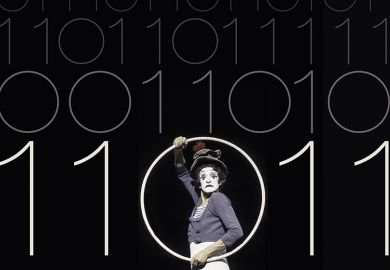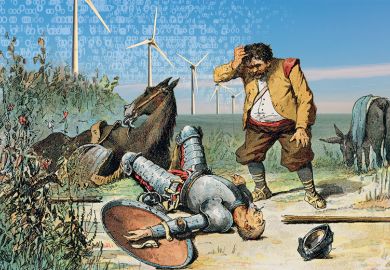Jean Aitchison delves into a new history of the English language and finds.
There can be little doubt that English is the most widely spoken language in the world... In such a situation an understanding of the nature of English can be claimed unambiguously to be of worldwide importance." This confident claim by the general editor of The Cambridge History of the English Language provides some explanation of the heftiness of the volumes in this series: each of the five (out of six) published so far contains more than 600 pages, though the volume under review is the longest and chunkiest: it weighs more than a kilo and is 5cm thick. Given this and the price, it is presumably mainly for library reading.
Those published so far have appeared in a somewhat random order. They run from the beginnings of English to the present time. Volume five deals with geographical varieties of English in Britain and throughout the world, and the final volume will explore English in North America.
Each chronologically ordered volume covers a decreasing number of years as it approaches the present: volume one takes in at least 500, volume two covers about 400, volume three more than 300, and this volume just over 200.
The avowed aim of the series is to produce "intermediate work which can provide a solid discussion of the full range of the history of English both to the Anglicist who does not specialise in the particular area to hand and to the general linguist who has no specialised knowledge of the history of English".
"The starting year of this volume is of course intentionally symbolic because it marks the declaration of independence of the United States of America from Britain," states editor Suzanne Romaine. Accordingly, she makes a decision to address the presumed "common core" of British and American English. The majority of chapters are in fact Britocentric.
"The most radical changes to English grammar had already taken place over the roughly one thousand years preceding the starting point of this volume," Romaine notes, asserting that the previous 300 years especially are widely regarded as the "formative period in the history of Modern Standard English".
In theory, then, this volume is concerned primarily with relatively minor changes, as well as with social and vocabulary changes.
In practice, the lack of sweeping changes is not immediately apparent to the superficial reader, who is plunged into a feast, or overdose, of changes, depending on his or her outlook: only someone with a reasonable knowledge of English and/or linguistics would be able to assess their weightiness.
The overall structure is much the same as in the preceding three volumes, with chapters on phonology and morphology, syntax, vocabulary, onomastics and literary language. It differs in that there is no chapter on regional and social variation - surprising as the editor's introduction specifically draws attention to the growth of sociolinguistic research in modern urban areas.
Instead, this volume contains a useful chapter on attitudes to language, which outlines views towards propriety and correctness. The chapters are of different lengths. The longest chapters are those by David Denison on syntax and Michael MacMahon on phonology, both more than 200 pages.
The shortest is a 41-page chapter on onomastics by Richard Coates. The varying lengths and varying styles of the chapters raise the question of whether the target audience has indeed been adequately addressed - though some chapters are undoubtedly outstanding in quality and usefulness.
Denison's chapter is exceptional in that it reports up-to-date research (some of it Denison's own), yet at the same time defines terminology and items to be discussed in a way that makes the text accessible to non-experts. On modal verbs, such as "can" and "will", he clearly specifies which verbs he is talking about: "We must start by considering the inventory of items which qualify for the label", pointing out disagreements among writers.
He defines lucidly the various types of meanings modals may have (so-called epistemic, deontic and dynamic meanings) with straightforward examples. He also discusses ongoing alterations, such as the increasing interchangeability of "may have" and "might have", as in: "if they (relevant safety warnings) had been (made public), action may have been taken and the disaster avoided" (from Which? magazine, 1989) - a usage that upsets some purists, though here shown to be widespread, with its possible sources discussed. A further strength of this chapter is that it tries to pin down changes to specific chunks of time within the 200 years covered, for example: "From the mid-18th century until roughly the 1860s, 'don't' was common in dialogue" - "Soaper praises people, don't he?" The whole chapter is admirably clear, yet it is not bedside, or even fireside, reading. It is very meaty and useful for anyone seeking clear, well-documented information about specific structures.
Ed Finegan's chapter, "English grammar and usage", is the most readable:
"The codification of English usage, not by an official academy but by a disparate band of independent entrepreneurs, constitutes the story of this chapter," he states, pointing out that it is a story above all of competition between prescriptive and descriptive ideals. "The raison d'etre of grammar has been prescription," he notes, and even today "there is... a resurrected sense that if only English grammar were taught properly in the schools, splendid social and moral benefits would shower like manna from heaven upon the citizens of righteous English-speaking communities." He provides a useful outline of prescriptive attitudes, with some clear, even vivid writing: "The 19th-century cloudburst of knowledge about linguistic evolution... helped prompt popular enthusiasm about language matters." He points out that attitudes to language have become a topic of increasing interest, and ends by suggesting that: "If the past is prelude, it is clear that the 21st century will see even the most descriptive dictionaries and grammars incorporating evaluation of usages as part of their descriptions."
Just as the chapter on attitudes is a worthwhile attempt to bridge the gap between scholarly and popular approaches to language, so the chapter on literary language by Sylvia Adamson is a praiseworthy effort at bridging the literature-language gap, as those who work on one side are often unsympathetic to the other. In practice, this chapter is somewhat dense: too much has happened in literature in 200 years for anyone to do justice to the topic in about 100 pages and retain a totally lucid direction of argument.
However, a strength of Adamson's contribution is that the points made are always well illustrated by literary quotations. For example, the use of adjectives in Gothic fiction is exemplified by a quotation from Ann Radcliffe's The Mysteries of Udolpho that contains phrases such as "tremendous appearance", "dreadful chasm".
The chapter on vocabulary is written by John Algeo of the University of Georgia. He has tried to make his contribution relevant to British readers. Yet his American outlook comes through: he claims controversially that "The most important general dictionary of the 20th century is Webster's Third New International Dictionary of the English Language (1961)", a tome that is treated as authoritative by many Americans, but is not widely consulted in Britain.
Algeo outlines sources of new words and compares the way word formation categories are represented in various contemporary collections of new words. He also documents different languages as sources of loanwords, pointing out that all recent dictionaries of new words agree in making French the greatest provider to English of loanwords, though he notes discrepancies in their assessment of other languages: for example, The Barnhart Dictionary Companion lists about five times as many Russian loanwords as any other, a discrepancy he tries to explain. A final, perhaps overbrief, section (in view of the book's intended audience) looks at vocabulary change as a mirror of cultural change.
Perhaps the main surprise in this volume, as in the other volumes, is the inclusion of a separate chapter on onomastics - the study of proper names.
Onomastics is normally regarded as part of lexicology, though it is admittedly understudied. Coates notes: "This article is the only one I know devoted entirely to the topic of naming in English after 1776. There are also no books on the topic." In the circumstances, it seems somewhat odd to include this inevitably sketchy chapter, when other chapters have clearly had to be pruned heavily in order to squeeze in even an outline account of the mass of evidence and literature available.
The least digestible chapter is - perhaps predictably - that on phonology. It would have been much clearer and more palatable with diagrams of vowel triangles for the vowels under discussion. As it is, perhaps only readers with a strong interest in and reasonable knowledge of phonology will manage to work through the details. A useful aspect of this chapter, however, is that the progressively more sophisticated attempts to describe the sound systems are outlined, as well as the development of the sound system itself.
A minor irritation of this whole volume (and others in the series) is that it takes time to navigate. Chapters are divided into sections and subsections, which sometimes run to four digits separated by dots, such as: 3.3.5.2. It is annoying to be told, for example, "cf. 3.2.2.5 above", with no page reference. Valuable minutes are lost trying to find subsections.
The disparity between the various contributions suggests that CHEL 's goal of appealing to intermediates and non-specialists is sometimes achieved, and sometimes not. In this volume, perhaps only Finegan's is likely to have wide allure, though the richness of Denison's will attract serious knowledge-seekers. It is also not clear that the volume has succeeded in addressing the presumed "common core" of British and American English. As already noted, the volume is heavily Britocentric - though this may be inevitable when a future (unpublished) volume on American English is scheduled.
An overall strength of the book, yet also an inherent weakness, is that it is for everybody and yet for nobody. It is engaging, because a broad range of topics is covered. Yet non-specialists are likely to have a hard time extracting relevant information. On the other hand, specialists may be frustrated by the way details are sometimes skated over.
However, for those who have the interest and patience, a huge amount of fascinating and worthwhile material is available for prising out. Reading this book reminded me of childhood blackberry-picking expeditions: pickers get exhausted, frustrated and scratched. But anyone who persists takes home after a struggle a basketful of delicious, winking dark berries.
Jean Aitchison is the Rupert Murdoch professor of language and communication, University of Oxford.
The Cambridge History of the English Language, Volume 4 1776-1997
Editor - Suzanne Romaine
ISBN - 0 521 264774
Publisher - Cambridge University Press
Price - £80.00
Pages - 707
Register to continue
Why register?
- Registration is free and only takes a moment
- Once registered, you can read 3 articles a month
- Sign up for our newsletter
Subscribe
Or subscribe for unlimited access to:
- Unlimited access to news, views, insights & reviews
- Digital editions
- Digital access to THE’s university and college rankings analysis
Already registered or a current subscriber? Login



